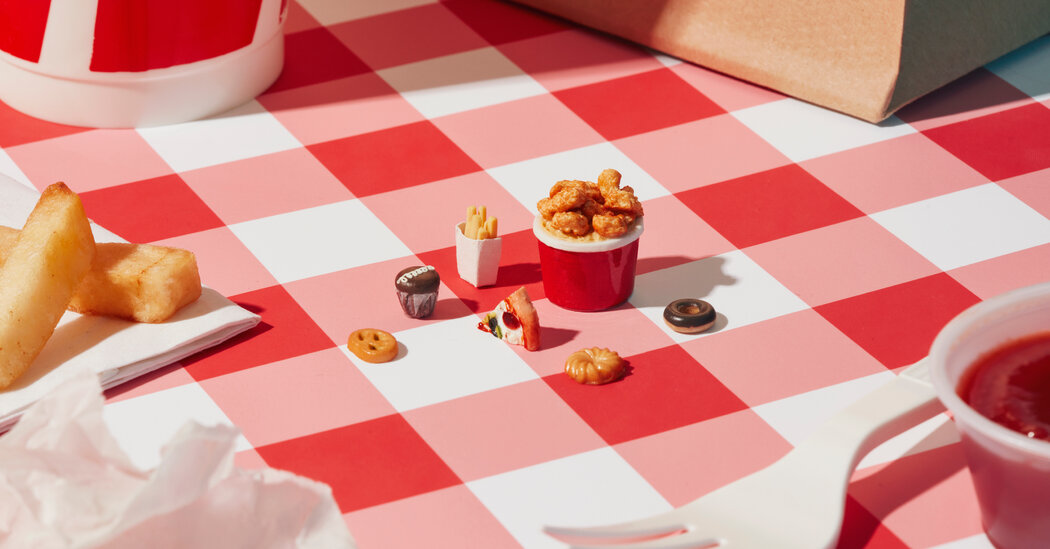For the Eat Well Challenge, mindfulness techniques like “urge surfing” can help curb overeating without banning favorite foods.
Food cravings are a normal part of the human experience; studies show that more than 90 percent of people have them. (In fact, who are those unicorns who’ve never had cravings?)
But how we deal with cravings can vary widely. Some people eat what they want and don’t worry about it, whereas others feel controlled by cravings and end up bingeing on favorite foods.
When people surrender to a food craving, they often blame it on a lack of self control. But cravings are caused by a complex interplay of neurons in the brain’s reward center, appetite hormones, behavioral conditioning and easy access to tasty, pleasurable foods that reinforce the craving cycle.
The power of cravings can be fueled by the senses, like the smell of fresh bread when we walk by a bakery, as well as situations and emotions. After a stressful day at work, for example, we might seek comfort by pulling up to a fast-food window. Good times can trigger cravings, too, like wanting popcorn or candy at the movies. And studies show that so-called “hyperpalatable” foods that offer a tantalizing combination of fat, sugar, salt and carbohydrates can interfere with brain signals so that we keep craving them even when we’re full.
So what’s the solution for people who struggle with cravings?
It turns out many people are dealing with cravings the wrong way by trying to restrict, avoid and distract themselves from tempting foods. They skip dessert when everyone else is eating it, walk away if a colleague brings doughnuts to the office and try to ignore their craving for the ice cream in the freezer.
But increasingly, studies show that constant restriction and attempts at distraction can actually backfire for people who struggle with cravings and binge eating.
Now scientists are studying surprising new strategies to cope with cravings based on brain science. These include accepting that food cravings are normal and inevitable and using mindfulness techniques to acknowledge and become more aware of your cravings and wait them out, rather than trying to ignore them.
“It’s about understanding that these kinds of cravings are a natural part of being a person; we’re engineered this way,” said Evan Forman, a psychology professor at Drexel University in Philadelphia and the director of the university’s Center for Weight, Eating and Lifestyle Science. “You don’t have to make cravings go away, but you also don’t have to eat because of them. It’s accepting rather than pushing away or suppressing them.”
How Dieting Can Make Cravings Worse
One of the earliest studies to show a link between food restriction and cravings was conducted in the 1940s by the diet researcher Ancel Keys. In what is often referred to as a “starvation study,” Dr. Keys asked 36 men, who had been eating about 3,500 daily calories, to cut their food intake to about 1,600 calories a day. (By today’s standards, that calorie count is just another diet.) The restriction triggered a notable psychological change in the men, who became preoccupied with food.
“They stopped doing anything except laying in their beds, talking and thinking about foods,” said Traci Mann, who heads the health and eating laboratory at the University of Minnesota. She notes that the men even planned food-related careers like opening a grocery store or restaurant, and they stayed preoccupied with food long after the study ended. “These are men in the 1940s who probably never cooked a meal in their entire life,” Dr. Mann noted. “And they started cutting recipes out of the newspaper.”
More recently, Dr. Mann and her colleagues used a tempting box of chocolates to study the effect of food restriction. The research included 142 chocolate lovers, half of whom were told to eat their regular diet while the other half went on a restricted diet. In a seemingly cruel twist, everyone in the study was given a box of chocolates and instructed not to eat it until after the 10-day study. But to make sure every participant was consistently tempted by the chocolate, the participants had to open the box daily to find specific instructions.
After 10 days, everyone was asked to send a photo of their chocolate box. The dieters had pilfered significantly more of the chocolates than those who weren’t counting calories.
“The dieters’ control over their eating failed,” Dr. Mann said. “There are lots of studies that look at the thinking processes that dieters have, and you see the same thing. Dieters are more likely to notice food, have a harder time removing their attention from food and they crave food more.”
Currently, Dr. Mann is studying how quickly obsessive food thoughts begin after a person starts restrictive dieting. “We’re still crunching the data,” Dr. Mann said. “But it seems to start up pretty quickly, within about 10 days.”
Acceptance vs. Distraction
At Drexel University, Dr. Forman conducted a similar study, but this time with transparent boxes of Hershey’s Kisses that subjects were required to carry at all times for two days. The researchers added a twist, advising some participants to ignore their cravings while instructing another group to notice and accept their cravings as something normal. A control group received no advice. At the end of the study, about 30 percent of participants in the control group had eaten the candy compared to 9 percent of people in the group instructed to ignore cravings. But among the participants taught to acknowledge and accept cravings, nobody ate the chocolate.
In 2019, Dr. Forman published the follow-up results of a larger randomized controlled trial of 190 people, which found that participants who practiced acceptance and mindfulness strategies were twice as likely to have maintained a 10 percent weight loss after three years compared to those who focused primarily on resisting temptations and suppressing thoughts of food.
“Surprisingly, there was a large benefit in people’s quality of life that was somewhat unexpected,” Dr. Forman said. “It benefited their well-being and emotional state, too.”
How to Cope With Cravings
For this week’s Eat Well Challenge, try these acceptance and mindfulness techniques to focus on food cravings. (Times subscribers can sign up for the Eat Well Challenge through the Well newsletter and receive extra advice by texting the word “Hi” to 917-810-3302 for a link to join.)
Practice “urge surfing.”
Cravings are ephemeral, and some research suggests they peak around 5 minutes. “Urge surfing” means “riding the wave” of your thoughts, feelings and cravings rather than acting on them, and it’s a successful strategy often used to treat substance use. Follow these four steps.
-
Identify your craving. Use the phrase, “I’m having the urge to eat …” and fill in the blank,.
-
Observe it. Notice how you feel as you crave the food. Do you feel it in your stomach? Are you distracted? Anxious? Do you feel the need to move or keep visiting the kitchen?
-
Be open. Don’t try to suppress or get rid of your craving. Accept the experience.
-
Pay attention to what happens next. Notice the urge as it rises, crests, falls and subsides. Note the intensity of a craving. “I’m having the urge to eat potato chips. It started as a 5, but now it’s a 7.”
“Our cravings inevitably rise and fall, just like waves in an ocean,” Dr. Forman said. “Trying to fight that wave will never work. It doesn’t work if you are wishing for the craving to go away. You are accepting that it’s there, and even that it’s supposed to be there, and you are coexisting — surfing — with it.”
Ask: How little is enough?
There’s nothing wrong with eating a food you crave unless it becomes a problem for you. Dr. Judson Brewer, an associate professor at the Brown University School of Public Health, who created a mindfulness app called Eat Right Now, told the story of a patient who routinely ate a full bag of potato chips while watching a favorite TV show with her daughter.
Instead of discouraging her from eating the chips, Dr. Brewer advised her to pay attention to every single chip she ate and to notice how many chips it took to feel satisfied. Just a few weeks later, the woman reported she had slowly reduced her chip habit, and now her craving was satisfied after the second potato chip.
“She could eat two and be done,” Dr. Brewer said.
Dr. Brewer said mindfulness can help people cope with food cravings without having to give up a favorite food entirely. “It’s not that we can’t ever have a chocolate chip cookie,” Dr. Brewer said. “But when I eat one, I really pay attention. I enjoy it, and I ask myself, ‘Do I need more?’”
Find a bigger, better offer.
Another strategy to deal with a craving is to focus on how a food tastes and makes you feel, and then replace a problem food with a higher-quality food that satisfies the same urges. Dr. Brewer calls this “finding a bigger, better offer.”
Dr. Brewer said he used to be “addicted” to gummy candy. To break the craving, he began to focus on how the candy really tasted, and noticed it was sickly sweet. He looked for a better food to feed his craving and chose blueberries, which he discovered gave him even more pleasure than the candy.
“Cutting ourselves off is not the way to go,” Dr. Brewer said. “We don’t want to live this austere life of not enjoying foods that taste good.”
On Mondays in January, the Eat Well Challenge will focus on the latest science to help you reshape your eating habits. Sign up for the Well newsletter to receive it in your inbox. You can also sign up for weekly texts with coaching and tips. Text the word “Hi” (or any word) to 917-810-3302 for a link to join. Message and data rates may apply.




























